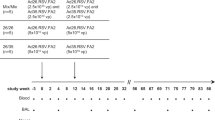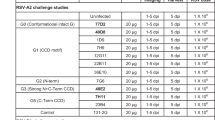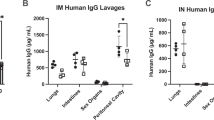Abstract
Respiratory syncytial virus (RSV) is widely recognized as a leading cause of pneumonia, with substantial mortality, in bone marrow transplant recipients. We tested the efficacy of a systemic monoclonal antibody (MAB) preparation possessing a high titer of anti-RSV neutralizing antibody, palivizumab (Synagis) for prophylaxis and therapy of RSV infection in cytoxan (CY) immunosuppressed cotton rats, a model in which the efficacy of a polyclonal anti-RSV product (Respigam) has been demonstrated. Both prophylaxis and therapy with this MAB were highly effective in reducing pulmonary viral replication. However, multiple sequential therapeutic doses of MAB were necessary to control rebound viral replication in continually suppressed animals.
Bone Marrow Transplantation (2002) 29, 117–120. doi:10.1038/sj.bmt.1703326
This is a preview of subscription content, access via your institution
Access options
Subscribe to this journal
Receive 12 print issues and online access
$259.00 per year
only $21.58 per issue
Buy this article
- Purchase on Springer Link
- Instant access to full article PDF
Prices may be subject to local taxes which are calculated during checkout


Similar content being viewed by others
References
Whimbey E, Englund JA, Couch RB . Community respiratory virus infections in immunocompromised patients with cancer Am J Med 1997 102: 10 18
Harrington RD, Hooton TM, Hackman RC et al. An outbreak of respiratory syncytial virus in a bone marrow transplant center J Infect Dis 1992 165: 987 993
Bowden RA . Respiratory virus infections after marrow transplantation: the Fred Hutchinson Cancer Center research experience Am J Med 1997 102: 27 30
McCarthy AJ, Kingman HM, Taylor GS et al. The outcome of 26 patients with respiratory syncytial virus infection following allogeneic stem cell transplantation Bone Marrow Transplant 1999 24: 1315 1322
Dreizin RS, Vyshnevetskaia LO, Bagdamian EE et al. Study of experimental respiratory syncytial virus infection in cotton rats: virologic and immunofluorescent studies Vopr Virusol 1971 16: 670 676
Ottolini MG, Porter DD, Hemming VG et al. Effectiveness of RSVIG prophylaxis and therapy of respiratory syncytial virus in an immunosuppressed animal model Bone Marrow Transplant 1999 24: 41 45
Prince GA, Jenson AB, Horswood RL et al. The pathogenesis of respiratory syncytial virus infection in cotton rats Am J Pathol 1978 93: 771 792
DeVincenzo JP, Hirsch RL, Fuentes RJ, Top FH Jr . Respiratory syncytial virus immune globulin treatment of lower respiratory tract infection in pediatric patients undergoing bone marrow transplantation – a compassionate use experience Bone Marrow Transplant 2000 25: 161 165
Gosh S, Champlin RE, Englund J et al. Respiratory syncytial virus upper respiratory tract illness in adult blood and marrow transplant recipients: combination therapy with aerosolized ribavirin and intravenous immunoglobulin Bone Marrow Transplant 2000 25: 751 755
Acknowledgements
This work was supported in part by Grant RO86DM.
Author information
Authors and Affiliations
Rights and permissions
About this article
Cite this article
Ottolini, M., Curtis, S., Mathews, A. et al. Palivizumab is highly effective in suppressing respiratory syncytial virus in an immunosuppressed animal model. Bone Marrow Transplant 29, 117–120 (2002). https://doi.org/10.1038/sj.bmt.1703326
Received:
Accepted:
Published:
Issue Date:
DOI: https://doi.org/10.1038/sj.bmt.1703326
Keywords
This article is cited by
-
Respiratory Syncytial Virus Infection in Older Adults: An Under-Recognized Problem
Drugs & Aging (2015)
-
Respiratory Viral Infections in Pediatric Solid Organ and Hematopoietic Stem Cell Transplantation
Current Infectious Disease Reports (2012)



